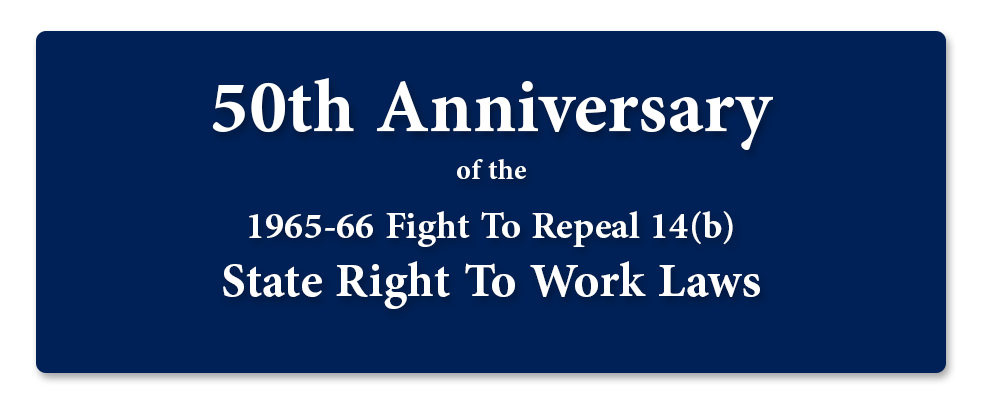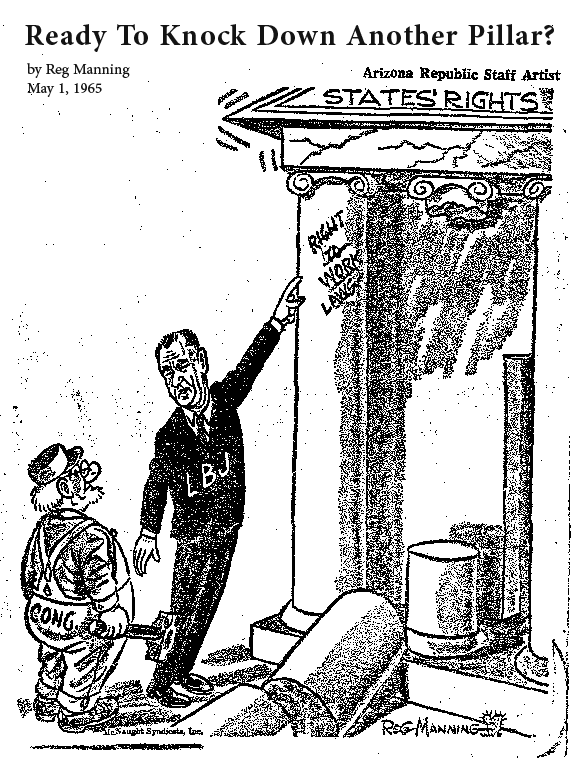It’s the 50th Anniversary of the 1965-66 Fight To Repeal 14(b) — federal recognition of State Right to Work Laws. What better way than to use National Right to Work icon Reed Larson’s words to rally America to Big Labor’s ultimate power grab. Mr. Larson wrote Forty-Four Words to help America realize that only Forty-Four Words keep union bosses from becoming “the unchallenged rulers of this nation’s entire economic and political life.”
For the next several months, the National Right to Work Committee will highlight the “14(b) fight” by publishing here and on Facebook commentaries, cartoons, and speeches from 1965 and 1966. Though many of these words were written and spoken many years ago, they remain relevant today as the Obama National labor Relations Board (NLRB) again tries to bypass elected officials in congress in order to undermine Right to Work protections. We hope that the past actions by so many will inspire America anew.

Forty-Four Words
(Taken from National Right to Work Committee Executive Vice-President Reed Larson’s 1965 call to action: Forty-Four Words)
In May 1965, a mighty storm fermented across the United States. It centered around 44 words of the federal law. Forty-four words which stand as the greatest single obstacle to a handful of top union officials who seek to become the unchallenged rulers of this nation’s entire economic and political life. This storm reached its full fury early in the first session of the 89th Congress.
Section 14(b) of the Taft-Hartley Act, in just 44 words, guarantees the right of States to pass and enforce State Right to Work laws, protecting all employees from compulsory unionism (except those covered by the Railway Labor Act).
Nothing in this Act shall be construed as authorizing the execution or application of agreements requiring membership in a labor organization as a condition of employment in any State or Territory in which such execution or application is prohibited by State or Territorial law.
– Labor Management Relations Act of 1947, known as the Taft–Hartley Act
To preserve individual freedom, the philosophy of limited government must prevail. The people of this nation joined and waged an all-out battle in defense of these vital 44 words.
 This simple guarantee of states’ rights is the real “bone in the throat” of a few top union officials who sought the role of unbridled union power as destiny for our Nation.
This simple guarantee of states’ rights is the real “bone in the throat” of a few top union officials who sought the role of unbridled union power as destiny for our Nation.
Top union officials openly state that there could be no such thing as “too much union power.” Both logic and experience confirm that the jealously-guarded power of union officials to conscript members through compulsory membership (“union shop”) contracts provides their real key to unbridled power.
Just a few days before the November 3, 1964 election, AFL-CIO Legislative Director Andrew Biemiller boasted that his union organization spent $1 million “for the election of President Johnson and 25 liberal congressmen in an effort to repeal Section 14(b) of the Taft-Hartley Act. In other words, to revoke the power of individual states to enact Right to Work laws.”
Other sources estimated that the AFL-CIO’s COPE (the political action machine) spent nearly $20 million on these Congressional and Presidential races. The money had its effect. COPE claimed that its efforts resulted in the election of approximately 110 additional members of Congress who will vote as instructed by the AFL-CIO. Union bosses claimed a majority of members of both houses of Congress would vote for all of “labor’s objectives.”
“Labor’s No. 1 objective” was and remains the destruction of Right to Work laws. Union spokesmen announced that the repeal of Section 14(b) was their foremost goal in the 1965-66 Congress.
However, Mr. Biemiller and his colleagues in the AFL-CIO hierarchy were not entirely confident, in spite of their election successes, that they would get Congress to repeal Section 14(b).
In a November 5th, 1964 dispatch, the Washington (D.C.) Evening Star labor news editor Lee Cohn said:
“Although the Democrat platform supports the AFL-CIO position, unionists recognize that they face a hard fight over Right to Work. They chose this issue deliberately as a tough test of labor’s congressional influence. Victory on this issue would open the gates for a lot of other legislation wanted by labor; an AFL-CIO official said.”
The National Right to Work Committee spearheaded the mobilization of Right to Work supporters throughout the nation to fight for the retention of Section 14 (b). The Committee emphasized the grave danger to the whole structure of individual freedom in the effort to repeal 14 (b).
We are calling the public’s attention to the expenditure of the vast amount of money, by union officialdom in the 1964 elections and noting that most of the money spent was collected under compulsion from rank and file union members – in the form of dues and fees.
This license to obtain millions of dollars by force (the 1964 combined labor union income in America is $4.5 billion annually) and then to use it to influence political races and legislation is an extremely dangerous license. Union bosses had this license in [24] of the 50 states.
Right to Work laws in [26] states prevent compulsory unionism and the forcing of non-union members to contribute to unions and their political activity against their will.
Because 67% of the people of America believe in the Right to Work principle, the union hierarchy fears the advance of Right to Work laws into every state which do not yet have this freedom safeguard.
Thus, they have declared the repeal of Section 14(b) to be their first objective in the 1965 Congress.
The people of Delaware, and perhaps particularly the owners, management and employees of the businesses and industries of the state, have a stake in the Congressional fight over 14 (b). While the state has never had a Right to Work law, or a significant effort to enact one. Delaware did have a “Little Taft-Hartley Act” in 1947, only to have it repealed under severe union pressure in 1949. However, the legislation was in no sense a prohibition of compulsory unionism.
A Right to Work proposal was introduced in the 1960’s but, again, union pressure kept it bottled up in committee, and it did not come to the floor for a vote.
Citizen leaders in recent years have sought to mobilize support for a statewide Right to Work organization which would, in time, spearhead a drive for legislation.
Recently progress in expanding the movement has been reported. The plan of the union hierarchy is to render utterly impotent any such citizen move in the states which do not have such a safeguard, and to destroy the state Right to Work laws already in existence through repeal of Taft-Hartley’s Section 14(b).
Under compulsory unionism, labor bosses are freed from any real responsibility to their members. By controlling jobs through compulsory unionism, they control workers, management, and politicians. Labor bosses – unscrupulous or well-intentioned, it makes no difference – are free to intimidate and harass non-conforming workers and to lead employers and politicians around by the nose “for the good of the union.”
Dramatizing the monopoly power gained through the closed “union shop” is the spectacle of a labor boss defying the United States Government, cowing Government officials and untold employees – testimony under oath to a Congressional committee that the hierarchy of a closed shop union includes criminals with long and sordid records – the statement of a United States Senator that one labor leader in coalition with another labor leader’s unions holds the power of life or death over the economy of the United States and warning that this coalition of closed shop unions would have greater economic power than the United States Government.
If further dramatization of the power of monopoly unionism were needed, it could be found in the transcript of testimony at the McClellan Committee hearings into the shameful work stoppages at the Nation’s two strategic missile bases, Cape Canaveral and Vandenberg, in the midst of our desperate efforts to counteract the growing might of Soviet Russia in missilery and space science.
The nationwide application of the principle of Right to Work remains virtually the only hope of breaking the hold of the labor bosses on the Nation’s jugular vein.
Shortly after World War II, widespread revulsion against excesses of labor bosses sparked an intensification of the movement to protect workers from compulsory unionism through the passage of State Right to Work laws.
Since the adoption of the first State Right to Work law in 1944, the number has grown to twenty-five states that now have these laws. Popular support is growing, and the total support is sure to grow at an increasing rate.
Recognizing that compulsory unionism is the key to limitless union power, union professionals have waged a vicious and continuous campaign against the spread of State Right to Work laws and for the repeal of those which are already in existence.
In 1962, a top spokesman for the AFL-CIO stated that the “entire resources” of the AFL-CIO were being mustered to stop the spread of Right to Work.
While the onslaught of limitless union money and organization temporarily slowed down the rate of Right to Work expansion, it cannot be stopped, and the number of Right to Work States continues to grow.
Efforts of professional unionists to wipe out existing Right to Work laws have been a miserable failure. In every test, Right to Work laws have been shown to become more familiar with the people the longer they are in effect.
On the other hand, where citizens have had experience with Right to Work in operation, votes have shown strong widespread endorsement.
Faced with the verdict of citizens who understand and have had experience with Right to Work laws, and the certainty that the total of State Right to Work laws will continue to grow, labor bosses now recognize that their only hope for imposing full compulsory unionism on the Nation is by striking down the authority of the States to pass and administer these laws.
Congressman Philip M. Landrum (D-GA), co-author of the Landrum-Griffin Act, declared flatly that should Section 14(b) be repealed, a form of “laborism” would ultimately supplant the historic American system of private enterprise and “individual citizens would quickly lose the right of free choice.” “Powerful union officials,” then-Congressman Landrum warned, “would not allow a choice. They would have the power to control every job, every industry in our nation, to challenge the right of individuals to work and of management to manage.”
The situation demands well-informed, alert citizens to mobilize friends and neighbors who will raise their voices in defense of those 44 words that can mean the difference between a free economy and total domination under a form of “laborism.”